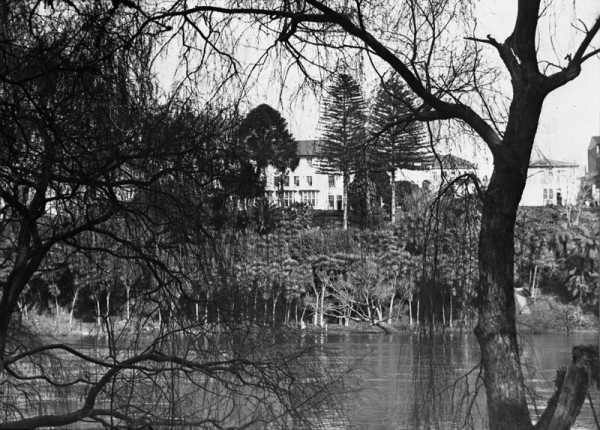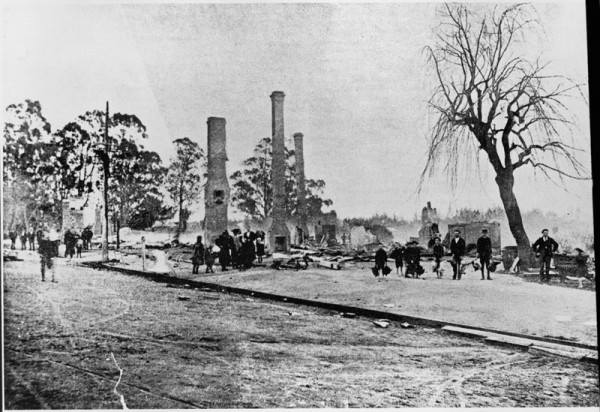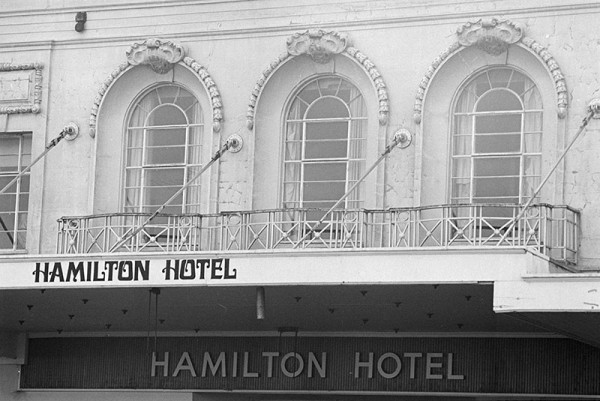Where Hamilton Gathered: The Rise and Fall of a Grand Hotel

The First Hamilton Hotel: 1865–1898
The original Hamilton Hotel opened in March 1865 under the ownership of Captain W.E. Turner, a former commander of the colonial paddle steamer PS Rangiriri. Despite not receiving his license to operate until 7 March, Turner began advertising the hotel as early as the 2nd, evidently confident in its success. The hotel quickly became a hub for civic and social life, hosting meetings for the Hamilton Highway Board, the Waikato Jockey Club, and the Hamilton Flour Mill Company (Limited).
In May 1872, under the ownership of James Harper, the hotel expanded significantly, adding a billiard room and 25 more bedrooms. However, Harper’s tenure was not without controversy. In 1874, he was charged under the Licensing Act for selling beer on a Sunday. That same year, a destructive fire struck Hamilton’s town centre. Harper played a notable role in saving property and sheltering displaced residents, though he remained a somewhat divisive figure.
Later in 1874, the hotel’s fortunes changed when it was taken over by Richard Gwynne and his wife Sarah, previously of the Junction Hotel in Newmarket, Auckland. The Gwynnes transformed the hotel into the social centre of Hamilton. They added another 14 bedrooms, a large commercial room, dining facilities, and several sitting rooms. Richard, also one of Hamilton Borough’s first councillors, was known for maintaining the hotel’s grounds with great care until his death in 1883.
Sarah Gwynne continued to manage the hotel for many years after, remaining an active and respected member of the community. Upon her retirement in 1897, and her death in 1906, The Observer described her as “an incomparable hostess... one of the model landladies of the province and a woman of uncommon kindliness, geniality, and force of character.”
After Sarah’s retirement, William and Agnes Bright briefly took over. Tragically, in less than a year, a devastating fire across the street spread rapidly. With no fire brigade in Hamilton at the time, 15 buildings were lost—including the original Hamilton Hotel, its stables, and its honeymoon cottage.
The Second Hamilton Hotel: 1899–1922
A new Hamilton Hotel was built and opened on 4 March 1899 under the ownership of L.D. Nathan Co. It featured 50 rooms, had a frontage of 81 feet, and extended back in two wings 68 feet deep. The Waikato Argus praised its appearance, writing that it “looked exceedingly well and had the effect of brightening up that portion of the street considerably.”
It quickly re-established itself as a centre of civic life and became the temporary headquarters of the newly formed Hamilton Club until their premises were completed on Grantham Street.
Tragedy struck again in 1922. On 3 April, a fire broke out that destroyed the second Hamilton Hotel and claimed three lives: Donald Moore, a travelling salesman; Nellie Partridge (née Wood), a maid; and celebrated artist Horace Moore-Jones. Moore-Jones initially escaped the building but re-entered in an attempt to save others. He later died from the burns he sustained. He was particularly known for his iconic World War I painting Simpson and His Donkey, and had only recently arrived in Hamilton to begin offering art classes.
The Third Hamilton Hotel: 1923–1980
A year later, in 1923, a third Hamilton Hotel rose from the ashes. Constructed of concrete and concrete block, the new building featured a distinctive Beaux-Arts architectural style, still unique in Hamilton to this day.
This iteration of the hotel became an elegant and modern venue, hosting various dignitaries over the decades, including several Governors-General and Prime Minister Gordon Coates. Its most famous guests arrived in 1953: Queen Elizabeth II and Prince Philip, who stayed for a night during their Coronation tour of New Zealand.
A New Chapter: From Hotel to Arts Centre
Despite its golden era, the Hamilton Hotel closed its doors in 1980. In 1981, the building was sold to Hamilton Arts Centre Ltd, a charitable trust that transformed it into a thriving arts and community centre, known locally as Left Bank. In 1985, the building was listed as a Category 2 historic place, recognising its architectural and cultural significance.
From its beginnings with Captain Turner to royal visitors and resilient rebirths after tragedy, the Hamilton Hotel has been more than just a place of lodging and it has been a witness to the city’s changing identity, a home for community, and a cornerstone of Hamilton’s heritage.

HCL_09257, Hamilton City Libraries

HCL_08891, Hamilton City Libraries

HCL_06909, Hamilton City Libraries

HCL_03304, Hamilton City Libraries


HCL_M00636.15, Hamilton City Libraries
Further reading:
New Zealand Herald 2 March 1865, p. 1
Daily Southern Cross 9 December 1867, p. 1
New Zealand Herald 1 February 1868, p. 6
New Zealand Herald 19 October 1870, p. 1
Daily Southern Cross 4 November 1870, p. 2
Waikato Times 2 May 1872, p. 3
Daily Southern Cross 26 November 1873
Waikato Times 2 July 1872
Waikato Times 5 March 1874
Waikato Times 14 April 1874, p. 2
Waikato Times 18 July 1874, p. 2
Auckland Star 3 December 1874, p. 3
Waikato Times 13 December 1879, p. 2
New Zealand Herald 28 May 1883, p. 5
The Observer 5 January 1907, p. 4
Thames Star 24 August 1897
Waikato Argus 7 March 1899, p. 2
Waikato Times 4 April 1922
Auckland Star 15 May 1923, p. 3
Auckland Star 6 June 1923, p. 7
Waikato Times 31 December 1953, p. 4
Waikato Times 31 March 1980, p. 8
Waikato Times 5 June 1980, p. 1
Coates, I (1962) On record: Being the reminiscences of Isaac Coates 1840 - 1932. Hamilton: Paul’s Book Arcade
Norris, H.C.M. (1956) Armed settlers: The story of the founding of Hamilton, New Zealand, 1864-1874. Hamilton: Paul’s Book Arcade
Norris, H.C.M. (1964) Settlers in depression: A history of Hamilton, New Zealand, 1875-1894. Auckland: Paul’s Book Arcade
Simmons, A., Byrnes, G., & Doolin, E.R., (1989) Buildings of historical significance in central Hamilton. Hamilton, NZ: Waikato Regional Committee, NZ Historic Places Trust
